由 c-c + + 中的库函数 rand ()导出了较好的伪随机数发生器(IJMSC-V5-N4-2)
c语言产生4位数的随机函数

c语言产生4位数的随机函数1.引言1.1 概述在此部分,我们将介绍关于C语言中随机函数的概述。
随机函数在计算机编程中起着至关重要的作用,它能够生成一系列随机数,为程序的执行过程增加不确定性和灵活性。
C语言提供了rand()函数来生成随机数。
这个函数能够返回一个伪随机数,它首先需要通过调用srand()函数设置一个种子值。
种子值是生成随机数算法的起始点,不同的种子值将产生不同的随机数序列。
C语言的随机函数虽然不是真正意义上的随机,但在大多数应用中已经足够满足需求。
为了提高随机性,我们可以通过调用time()函数来获取当前时间作为随机数的种子值。
这样,每次运行程序时都会得到一个不同的种子值,从而生成不同的随机数序列。
本文的目的是介绍如何使用C语言中的随机函数来生成一个4位数的随机数。
我们将讨论生成4位数的方法,并通过示例代码展示具体实现过程。
希望读者通过本文的学习能够掌握C语言中随机函数的使用,并能够灵活运用于其他项目中。
接下来,在第二部分中,我们将更详细地介绍C语言中的随机函数和生成4位数的方法。
1.2 文章结构文章结构部分的内容:本文主要分为引言、正文和结论三个部分。
引言部分概述了文章的主题和目的,介绍了本文主要讨论的问题——如何使用C语言编写生成4位数的随机函数。
文章结构清晰,逻辑性强。
正文部分分为两个小节。
首先,2.1小节讲解了C语言中的随机函数的基本概念和使用方法,详细介绍了如何在C语言中调用随机函数生成随机数。
其次,2.2小节阐述了生成4位数的方法,提供了一种具体的实现思路,包括生成一个4位数的步骤,并给出了相关的代码示例。
结论部分分为总结和结果分析两个小节。
在3.1小节中,对整篇文章进行了总结,强调了本文讨论的问题和解决方法。
在3.2小节中,对结果进行了分析,探讨了该方法的可行性和效果,并提出了可能存在的改进空间。
通过上述的文章结构,读者可以清晰地了解本文的内容和组织,便于阅读和理解。
CC++中如何产生伪随机数
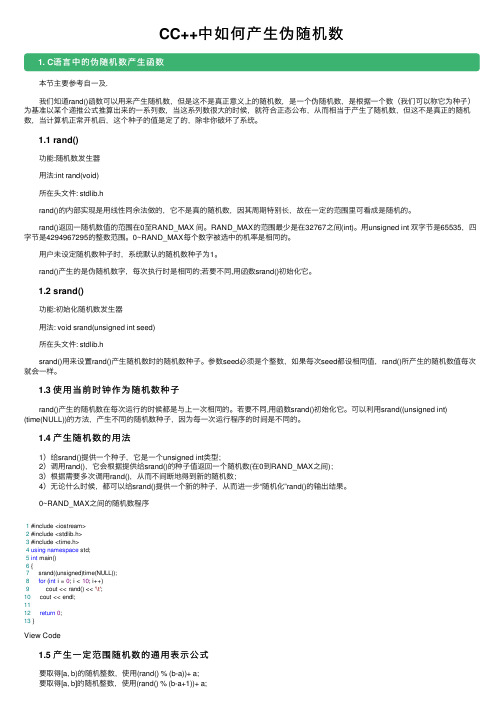
CC++中如何产⽣伪随机数 本节主要参考⾃⼀及. 我们知道rand()函数可以⽤来产⽣随机数,但是这不是真正意义上的随机数,是⼀个伪随机数,是根据⼀个数(我们可以称它为种⼦)为基准以某个递推公式推算出来的⼀系列数,当这系列数很⼤的时候,就符合正态公布,从⽽相当于产⽣了随机数,但这不是真正的随机数,当计算机正常开机后,这个种⼦的值是定了的,除⾮你破坏了系统。
1.1 rand() 功能:随机数发⽣器 ⽤法:int rand(void) 所在头⽂件: stdlib.h rand()的内部实现是⽤线性同余法做的,它不是真的随机数,因其周期特别长,故在⼀定的范围⾥可看成是随机的。
rand()返回⼀随机数值的范围在0⾄RAND_MAX 间。
RAND_MAX的范围最少是在32767之间(int)。
⽤unsigned int 双字节是65535,四字节是4294967295的整数范围。
0~RAND_MAX每个数字被选中的机率是相同的。
⽤户未设定随机数种⼦时,系统默认的随机数种⼦为1。
rand()产⽣的是伪随机数字,每次执⾏时是相同的;若要不同,⽤函数srand()初始化它。
1.2 srand() 功能:初始化随机数发⽣器 ⽤法: void srand(unsigned int seed) 所在头⽂件: stdlib.h srand()⽤来设置rand()产⽣随机数时的随机数种⼦。
参数seed必须是个整数,如果每次seed都设相同值,rand()所产⽣的随机数值每次就会⼀样。
1.3 使⽤当前时钟作为随机数种⼦ rand()产⽣的随机数在每次运⾏的时候都是与上⼀次相同的。
若要不同,⽤函数srand()初始化它。
可以利⽤srand((unsigned int) (time(NULL))的⽅法,产⽣不同的随机数种⼦,因为每⼀次运⾏程序的时间是不同的。
1.4 产⽣随机数的⽤法 1)给srand()提供⼀个种⼦,它是⼀个unsigned int类型; 2)调⽤rand(),它会根据提供给srand()的种⼦值返回⼀个随机数(在0到RAND_MAX之间); 3)根据需要多次调⽤rand(),从⽽不间断地得到新的随机数; 4)⽆论什么时候,都可以给srand()提供⼀个新的种⼦,从⽽进⼀步“随机化”rand()的输出结果。
C语言的随机数rand()函数详解
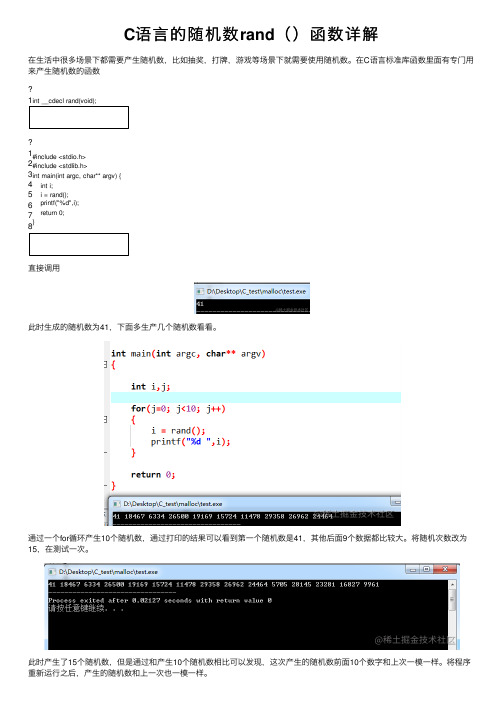
C 语⾔的随机数rand ()函数详解在⽣活中很多场景下都需要产⽣随机数,⽐如抽奖,打牌,游戏等场景下就需要使⽤随机数。
在C 语⾔标准库函数⾥⾯有专门⽤来产⽣随机数的函数1234567#include <stdio.h>#include <stdlib.h>intmain(int argc, char** argv) {int i;i = rand();printf("%d",i);return 0;}直接调⽤此时⽣成的随机数为41,下⾯多⽣产⼏个随机数看看。
通过⼀个for 循环产⽣10个随机数,通过打印的结果可以看到第⼀个随机数是41,其他后⾯9个数据都⽐较⼤。
将随机次数改为15,在测试⼀次。
此时产⽣了15个随机数,但是通过和产⽣10个随机数相⽐可以发现,这次产⽣的随机数前⾯10个数字和上次⼀模⼀样。
将程序重新运⾏之后,产⽣的随机数和上⼀次也⼀模⼀样。
这时什么原因呢?难道随机数⽣成函数实际上通过种⼦的值是由函数没有返回值,它的参数就是需要设置的种⼦值。
将修改种⼦的函数也添加到代码中。
将种⼦值设置为10,然后⽣成10个随机数。
将种⼦值设置为20,然后⽣成10个随机数。
可以看到当种⼦的值发⽣变化后,⽣成的随机数也就发⽣了变化。
如果程序中需要重复的使⽤随机的话,那么随机种⼦的值就不能时⼀个定值,它必须时刻发⽣变化,这么⽣成的随机数才能时刻发⽣变化。
在系统中时刻发⽣变化的数字,⾸先能想到的就是时间,因为时间实时都在发⽣变化,不可能出现同样的值。
那么就可以将获取系统的时间,然后作为随机数的种⼦。
时间函数*_Time) { return_time64(_Time); }调⽤调⽤要控制数字的范围,那么可以使⽤数学的取余数运算,如果要将⽣成的数字控制在10以内,那么对⽣成的数字除以10,然后取余数。
这样余数的⼤⼩就不会超过10。
这⾥对⽣成的随机数除以100取余,这样最后产⽣的随机数都会在100以内。
用c语言产生随机数rand()

用c语言产生随机数rand()在C语言中,rand()函数可以用来产生随机数,但是这不是真真意义上的随机数,是一个伪随机数,是根据一个数,我们可以称它为种子,为基准以某个递推公式推算出来的一系数,当这系列数很大的时候,就符合正态公布,从而相当于产生了随机数,但这不是真正的随机数,当计算机正常开机后,这个种子的值是定了的,除非你破坏了系统,为了改变这个种子的值,C提供了srand()函数,它的原形是void srand( int a)。
可能大家都知道C语言中的随机函数random,可是random函数并不是ANSI C标准,所以说,random函数不能在gcc,vc等编译器下编译通过。
rand()会返回一随机数值,范围在0至RAND_MAX 间。
返回0至RAND_MAX之间的随机数值,RAND_MAX定义在stdlib.h,(其值至少为32767)我运算的结果是一个不定的数,要看你定义的变量类型,int整形的话就是32767。
在调用此函数产生随机数前,必须先利用srand()设好随机数种子,如果未设随机数种子,rand()在调用时会自动设随机数种子为1。
一般用for语句来设置种子的个数。
具体见下面的例子。
一如何产生不可预见的随机序列呢利用srand((unsigned int)(time(NULL))是一种方法,因为每一次运行程序的时间是不同的。
在C语言里所提供的随机数发生器的用法:现在的C编译器都提供了一个基于ANSI标准的伪随机数发生器函数,用来生成随机数。
它们就是rand()和srand()函数。
这二个函数的工作过程如下:1) 首先给srand()提供一个种子,它是一个unsigned int类型,其取值范围从0~65535;2) 然后调用rand(),它会根据提供给srand()的种子值返回一个随机数(在0到32767之间)3) 根据需要多次调用rand(),从而不间断地得到新的随机数;4) 无论什么时候,都可以给srand()提供一个新的种子,从而进一步“随机化”rand()的输出结果。
c语言中的rand()函数

c语言中的rand()函数rand()函数是C语言中的一个库函数,用于生成一个随机数。
这个函数需要设置一个种子来确定生成的随机数序列。
在C语言中,使用srand()函数来设置种子,如果不设置种子,则默认使用系统时钟作为种子。
当需要多次调用rand()函数生成不同的随机数时,应该在程序中设置一个固定的种子。
```cint rand(void);```该函数返回一个介于0和RAND_MAX(一个定义为最大值的编译时常量)之间的整数随机数。
例如,下面的代码生成一个随机数:```c#include <stdio.h>#include <stdlib.h>#include <time.h>在这个例子中,我们使用srand()函数设置种子,time(NULL)返回当前时间的秒数。
这样每次运行程序需要生成不同的随机数时,种子都会不同,因此生成的随机数也会不同。
rand()函数的内部实现是生成一个线性同余的伪随机数序列。
每次调用函数时,该序列的下一个数字被计算出来。
为了增加随机性,常常使用时间、进程id、线程id等系统变量作为种子,从而使每轮生成的随机数序列尽量接近自然随机数的特性。
当需要生成一定范围内的随机数时,我们可以使用取余的方式获取所需的随机数。
例如,下面的代码生成1到100之间的随机数:这个程序中,我们生成一个介于0到99之间的随机数,然后加上1,得到一个介于1到100之间的随机数。
总之,rand()函数是C语言中一个常用的函数,用于生成伪随机数。
在使用rand()函数时,需要根据场景设置不同的种子,以使生成的随机数尽量接近自然随机数的特性。
c语言范围内随机数
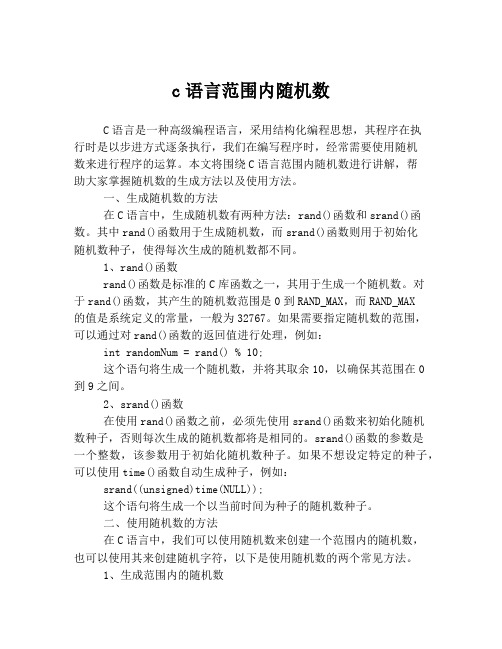
c语言范围内随机数C语言是一种高级编程语言,采用结构化编程思想,其程序在执行时是以步进方式逐条执行,我们在编写程序时,经常需要使用随机数来进行程序的运算。
本文将围绕C语言范围内随机数进行讲解,帮助大家掌握随机数的生成方法以及使用方法。
一、生成随机数的方法在C语言中,生成随机数有两种方法:rand()函数和srand()函数。
其中rand()函数用于生成随机数,而srand()函数则用于初始化随机数种子,使得每次生成的随机数都不同。
1、rand()函数rand()函数是标准的C库函数之一,其用于生成一个随机数。
对于rand()函数,其产生的随机数范围是0到RAND_MAX,而RAND_MAX的值是系统定义的常量,一般为32767。
如果需要指定随机数的范围,可以通过对rand()函数的返回值进行处理,例如:int randomNum = rand() % 10;这个语句将生成一个随机数,并将其取余10,以确保其范围在0到9之间。
2、srand()函数在使用rand()函数之前,必须先使用srand()函数来初始化随机数种子,否则每次生成的随机数都将是相同的。
srand()函数的参数是一个整数,该参数用于初始化随机数种子。
如果不想设定特定的种子,可以使用time()函数自动生成种子,例如:srand((unsigned)time(NULL));这个语句将生成一个以当前时间为种子的随机数种子。
二、使用随机数的方法在C语言中,我们可以使用随机数来创建一个范围内的随机数,也可以使用其来创建随机字符,以下是使用随机数的两个常见方法。
1、生成范围内的随机数如前所述,使用rand()函数可以生成一个在0到RAND_MAX之间的随机数,但是如果需要创建一个在指定范围内的随机数,可以使用如下方法:int randomNum = min + (rand() % (max - min + 1));其中min和max表示随机数的最小值和最大值,randomNum则表示生成的随机数。
rand函数生成随机数

rand函数生成随机数
Rand函数是C语言中的一个标准库函数,可以用来生成伪随机数。
在使用Rand函数的时候,需要用srand函数来为Rand函数设置一个种子来保证生成的随机数的唯一性。
Rand函数的返回值是一个整型值,可以使用模运算来控制生成的随机数的范围。
比如,如果要生成0~99之间的随机数,需要用Rand函数生成一个大于等于0小于等于RAND_MAX的随机数,然后用模运算将其限制在0~99之间。
Rand函数的使用场景很广泛,比如在游戏开发中用来生成随机的游戏地图,或者在密码学中用来生成随机的密钥。
由于Rand函数生成的随机数是伪随机数,因此在一定程度上可以保证安全性和随机性。
但是,为了保证生成的随机数的质量和熵,需要选取和设置合适的种子和模数。
除了Rand函数之外,还有其他的随机数生成算法,比如线性同余发生器、梅森旋转算法等。
这些算法的优劣取决于生成的随机数的分布情况、周期、速度和复杂度等因素。
总之,Rand函数是一种常用的生成随机数的方法,通过合理的设置种
子和模数可以生成高质量的随机数。
在使用随机数的时候,需要注意随机数的唯一性和安全性问题。
c rand函数

c rand函数
rand()函数在C语言中是一个很重要的函数,它可以帮助我们实现随机数字的产生。
rand()函数在C语言标准库stdlib.h中也有一
个定义,它提供了常见的伪随机数生成器(PRNG)。
除此之外,它还
提供了一种有用的随机数服务,为程序的设计者提供了有用的选择。
rand()函数有两个主要的参数:种子和峰值。
种子是初始化随机数发生器的值,它由程序员提供。
rand()函数中的种子可以设置为以下值:0(也可以设置为其他数值)。
种子值越大,产生的随机数越接近于零。
峰值是随机数范围的上限,它也可以设置为任意的大小,但最好不要设置过大,以免造成溢出。
如果没有传入种子参数,rand()函数仍然可以正常工作,但这通常会导致程序出现重复的随机数序列,这就是为什么我们要使用种子参数的原因了。
如果需要随机地从一组数据中选择一个数据,可以使用rand()函数来实现,效果很好。
除了rand()函数外,C语言中还有一些其他与随机数相关的函数,如srand()函数,它用于重新设定随机数种子。
srand()函数可以使rand()函数调用的随机数不致于重复出现。
此外,还有一些其他的随机数函数,如mrand48()、lrand48()
和srand48()函数等,它们也是C语言标准库中的一部分,可以满足用户更复杂的随机数需求。
总之,rand()函数对于C语言程序开发者而言是一个非常实用的函数,它可以帮助程序员产生伪随机数,从而实现更加复杂的程序设
计。
它也可以帮助程序员解决许多随机数相关的问题,为程序设计和实现提供有用的选择。
rand函数用法

rand函数用法rand函数是一种随机函数,它可以生成指定范围内的随机数。
它是许多编程语言中常用的函数之一,如C,C++,Java,PHP,Python 等。
它的原理是:在给定的范围内,根据一个确定的算法生成一个完全随机的数字,来满足程序所需要的随机数应用。
rand函数的具体用法在不同编程语言中有不同,其中最常用的分别是C,C++,Java,PHP,Python等,下面就这几种语言的rand 函数的用法做一个简单介绍。
首先介绍C语言中rand函数的用法,C语言中rand函数的原型如下:int rand(void);它的作用是从伪随机数发生器中返回一个在0~RAND_MAX之间的随机数,其中RAND_MAX是C语言中的宏,它的值为32767.用法如下:int x = rand();这样我们就可以在程序中得到一个0~32767之间的随机数,当然如果我们想取0~m之间的随机数,可以将上述语句改为int x = rand()% m + 1;这样就可以得到0~m之间的随机数了。
接下来介绍C++中rand函数的用法,C++中rand函数的原型如下:int rand(int m);它的作用是从伪随机数发生器中返回一个0或大于0的小于参数m的整数,参数m的取值范围是1~32768;用法如下:int x = rand(m);这样我们就可以在程序中得到一个0~m之间的随机数了。
紧接着介绍java中rand函数的用法,java中rand函数的原型如下:int rand(int m);其作用和C++中的rand函数是一样的,也是从伪随机数发生器中返回一个0或大于0的小于参数m的整数,参数m的取值范围也是1~32768,用法如下:int x = rand(m);这样我们也可以在程序中得到一个0~m之间的随机数了。
随后介绍 PHP 中rand函数的用法,PHP中rand函数的原型如下:int rand(min,max);它的作用是从伪随机数发生器中返回一个min和max之间的随机整数,min和max的取值范围为 0 ~ 32767用法如下:int x = rand(min,max);这样我们就可以得到min和max之间的随机数。
c语言随机数 底层逻辑
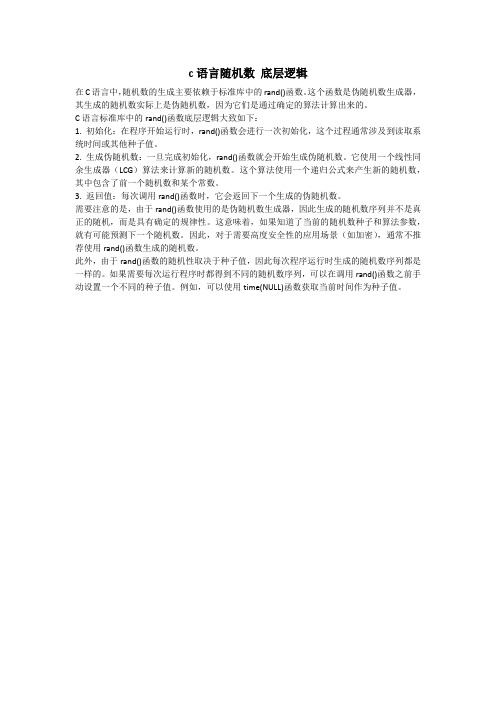
c语言随机数底层逻辑
在C语言中,随机数的生成主要依赖于标准库中的rand()函数。
这个函数是伪随机数生成器,其生成的随机数实际上是伪随机数,因为它们是通过确定的算法计算出来的。
C语言标准库中的rand()函数底层逻辑大致如下:
1. 初始化:在程序开始运行时,rand()函数会进行一次初始化,这个过程通常涉及到读取系统时间或其他种子值。
2. 生成伪随机数:一旦完成初始化,rand()函数就会开始生成伪随机数。
它使用一个线性同余生成器(LCG)算法来计算新的随机数。
这个算法使用一个递归公式来产生新的随机数,其中包含了前一个随机数和某个常数。
3. 返回值:每次调用rand()函数时,它会返回下一个生成的伪随机数。
需要注意的是,由于rand()函数使用的是伪随机数生成器,因此生成的随机数序列并不是真正的随机,而是具有确定的规律性。
这意味着,如果知道了当前的随机数种子和算法参数,就有可能预测下一个随机数。
因此,对于需要高度安全性的应用场景(如加密),通常不推荐使用rand()函数生成的随机数。
此外,由于rand()函数的随机性取决于种子值,因此每次程序运行时生成的随机数序列都是一样的。
如果需要每次运行程序时都得到不同的随机数序列,可以在调用rand()函数之前手动设置一个不同的种子值。
例如,可以使用time(NULL)函数获取当前时间作为种子值。
用C语言产生随机数1

} 而产生 1~100 之间的随机数可以这样写:
#include <stdlib.h> #include <stdio.h> #include <time.h> main( ) {int i; srand( (unsigned)time( NULL ) );
int a[100]={0}; int i,m; for(i=1; i<=99; ++i)
printf("%4d",a[i] );
srand( (unsigned)time( NULL ) );
or(i=1; i<=99; i++)
{
while(a[m=rand()%100+1]);
a[m] = i;
int i; randomize(); printf("Ten random numbers from 0 to 99\n\n"); for(i=0; i<10; i++)
printf("%d\n", rand() % 100); return 0; } 在《计算机常用算法》中有介绍随机数的生成算法 三 如何产生设定范围内的随机数
for( i = 0; i < 10;i++ ) printf( "%d\n", rand()%100+1);
} 二,三个通用的随机数发生器,推荐用第三个 函数名: rand 功 能: 随机数发生器 用 法: void rand(void);
用C语言的rand和srand产生伪随机数的方法总结

用C语言的rand和srand产生伪随机数的方法总结第一篇:用C语言的rand和srand产生伪随机数的方法总结标准库(被包含于中)提供两个帮助生成伪随机数的函数:函数一:int rand(void);从srand(seed)中指定的seed开始,返回一个[seed, RAND_MAX(0x7fff))间的随机整数。
函数二:void srand(unsigned seed);参数seed是rand()的种子,用来初始化rand()的起始值。
可以认为rand()在每次被调用的时候,它会查看:1)如果用户在此之前调用过srand(seed),给seed指定了一个值,那么它会自动调用srand(seed)一次来初始化它的起始值。
2)如果用户在此之前没有调用过srand(seed),它会自动调用srand(1)一次。
根据上面的第一点我们可以得出:1)如果希望rand()在每次程序运行时产生的值都不一样,必须给srand(seed)中的seed一个变值,这个变值必须在每次程序运行时都不一样(比如到目前为止流逝的时间)。
2)否则,如果给seed指定的是一个定值,那么每次程序运行时rand()产生的值都会一样,虽然这个值会是[seed, RAND_MAX (0x7fff))之间的一个随机取得的值。
3)如果在调用rand()之前没有调用过srand(seed),效果将和调用了srand(1)再调用rand()一样(1也是一个定值)。
举几个例子,假设我们要取得0~6之间的随机整数(不含6本身):例一,不指定seed: for(int i=0;i<10;i++){ ran_num=rand()% 6;cout< //…srand((unsigned)time(0));for(inti=0;i<10;i++){ ran_num=rand()% 6;cout<time_t被定义为长整型,它返回从1970年1月1日零时零分零秒到目前为止所经过的时间,单位为秒。
c语言中rand用法

c语言中rand用法在C 语言中,`rand` 函数用于生成伪随机数。
以下是`rand` 函数的基本用法:1. 包含头文件:首先,你需要包含`<stdlib.h>` 头文件,因为`rand` 函数的声明位于该头文件中。
```c#include <stdlib.h>```2. 初始化随机数生成器:在使用`rand` 函数之前,建议使用`srand` 函数对随机数生成器进行初始化。
你可以使用当前时间作为随机数生成器的种子,以保证每次运行程序时都会产生不同的随机数序列。
```c#include <stdlib.h>#include <time.h>int main() {// 使用当前时间作为随机数生成器的种子srand(time(NULL));// 其他代码...return 0;}```3. 生成随机数:使用`rand` 函数生成伪随机数。
这个函数返回一个在范围[0, `RAND_MAX`] 内的整数。
```c#include <stdlib.h>#include <time.h>#include <stdio.h>int main() {srand(time(NULL));// 生成随机数int randomNumber = rand();// 输出随机数printf("Random Number: %d\n", randomNumber);// 其他代码...return 0;}```4. 生成指定范围的随机数:如果你想生成在指定范围内的随机数,可以使用取余运算符`%`:```c#include <stdlib.h>#include <time.h>#include <stdio.h>int main() {srand(time(NULL));// 生成在[1, 100] 范围内的随机数int randomNumber = rand() % 100 + 1;// 输出随机数printf("Random Number: %d\n", randomNumber);// 其他代码...return 0;}```以上就是`rand` 函数的基本用法。
c语言软随机数实现方法
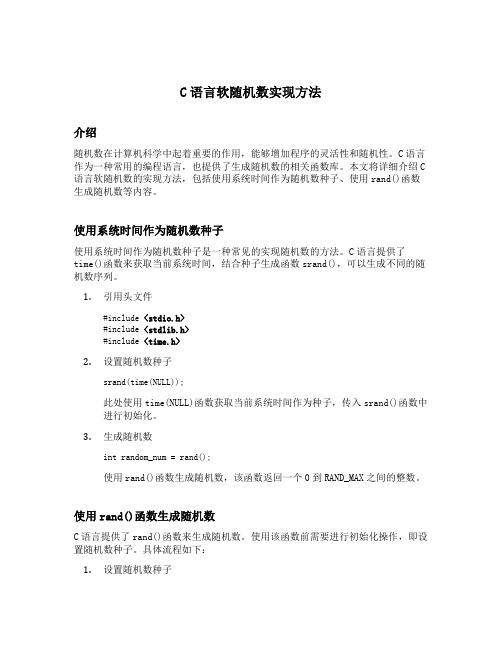
C语言软随机数实现方法介绍随机数在计算机科学中起着重要的作用,能够增加程序的灵活性和随机性。
C语言作为一种常用的编程语言,也提供了生成随机数的相关函数库。
本文将详细介绍C 语言软随机数的实现方法,包括使用系统时间作为随机数种子、使用rand()函数生成随机数等内容。
使用系统时间作为随机数种子使用系统时间作为随机数种子是一种常见的实现随机数的方法。
C语言提供了time()函数来获取当前系统时间,结合种子生成函数srand(),可以生成不同的随机数序列。
1.引用头文件#include <stdio.h>#include <stdlib.h>#include <time.h>2.设置随机数种子srand(time(NULL));此处使用time(NULL)函数获取当前系统时间作为种子,传入srand()函数中进行初始化。
3.生成随机数int random_num = rand();使用rand()函数生成随机数,该函数返回一个0到RAND_MAX之间的整数。
使用rand()函数生成随机数C语言提供了rand()函数来生成随机数。
使用该函数前需要进行初始化操作,即设置随机数种子。
具体流程如下:1.设置随机数种子srand(seed);随机数种子可以是任意整数值,通常使用系统时间作为种子以增加随机性。
2.生成随机数int random_num = rand();使用rand()函数生成随机数,该函数返回一个0到RAND_MAX之间的整数。
使用范例下面是一个使用系统时间作为随机数种子、生成随机数的示例代码:#include <stdio.h>#include <stdlib.h>#include <time.h>int main() {// 设置随机数种子srand(time(NULL));// 生成随机数int random_num = rand();// 输出随机数printf("随机数:%d\n", random_num);return 0;}总结本文介绍了C语言软随机数的实现方法,主要包括使用系统时间作为随机数种子和使用rand()函数生成随机数。
转:随机数产生原理及应用
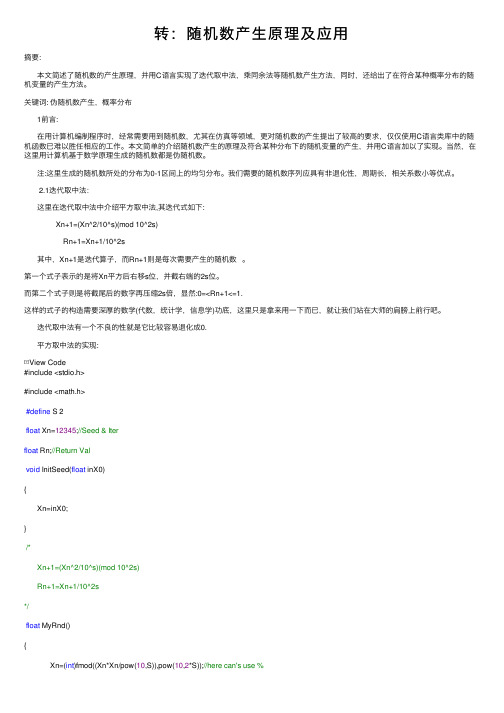
转:随机数产⽣原理及应⽤摘要:本⽂简述了随机数的产⽣原理,并⽤C语⾔实现了迭代取中法,乘同余法等随机数产⽣⽅法,同时,还给出了在符合某种概率分布的随机变量的产⽣⽅法。
关键词: 伪随机数产⽣,概率分布1前⾔:在⽤计算机编制程序时,经常需要⽤到随机数,尤其在仿真等领域,更对随机数的产⽣提出了较⾼的要求,仅仅使⽤C语⾔类库中的随机函数已难以胜任相应的⼯作。
本⽂简单的介绍随机数产⽣的原理及符合某种分布下的随机变量的产⽣,并⽤C语⾔加以了实现。
当然,在这⾥⽤计算机基于数学原理⽣成的随机数都是伪随机数。
注:这⾥⽣成的随机数所处的分布为0-1区间上的均匀分布。
我们需要的随机数序列应具有⾮退化性,周期长,相关系数⼩等优点。
2.1迭代取中法:这⾥在迭代取中法中介绍平⽅取中法,其迭代式如下:Xn+1=(Xn^2/10^s)(mod 10^2s)Rn+1=Xn+1/10^2s其中,Xn+1是迭代算⼦,⽽Rn+1则是每次需要产⽣的随机数。
第⼀个式⼦表⽰的是将Xn平⽅后右移s位,并截右端的2s位。
⽽第⼆个式⼦则是将截尾后的数字再压缩2s倍,显然:0=<Rn+1<=1.这样的式⼦的构造需要深厚的数学(代数,统计学,信息学)功底,这⾥只是拿来⽤⼀下⽽已,就让我们站在⼤师的肩膀上前⾏吧。
迭代取中法有⼀个不良的性就是它⽐较容易退化成0.平⽅取中法的实现:View Code#include <stdio.h>#include <math.h>#define S 2float Xn=12345;//Seed & Iterfloat Rn;//Return Valvoid InitSeed(float inX0){Xn=inX0;}/*Xn+1=(Xn^2/10^s)(mod 10^2s)Rn+1=Xn+1/10^2s*/float MyRnd(){Xn=(int)fmod((Xn*Xn/pow(10,S)),pow(10,2*S));//here can's use %Rn=Xn/pow(10,2*S);return Rn;}/*测试主程序,注意,这⾥只列举⼀次测试主程序,以下不再重复*/int main(){int i;FILE * debugFile;if((debugFile=fopen("outputData.txt","w"))==NULL){fprintf(stderr,"open file error!");return -1;}printf("\n");for(i=0;i<100;i++){tempRnd=MyRnd();fprintf(stdout,"%f ",tempRnd);fprintf(debugFile,"%f ",tempRnd);}getchar();return0;}前⼀百个测试⽣成的随机数序列:0.399000 0.920100 0.658400 0.349000 0.180100 0.243600 0.934000 0.235600 0.550700 0.327000 0.692900 0.011000 0.012100 0.014600 0.021300 0.045300 0.205200 0.210700 0.439400 0.307200 0.437100 0.105600 0.115100 0.324800 0.549500 0.195000 0.802500 0.400600 0.048000 0.230400 0.308400 0.511000 0.112100 0.256600 0.584300 0.140600 0.976800 0.413800 0.123000 0.512900 0.306600 0.400300 0.024000 0.057600 0.331700 0.002400 0.000500 0.000000 0.000000 0.000000 0.000000 0.000000 0.000000 0.000000 0.000000 0.000000 0.000000 0.000000 0.000000 0.000000 0.000000 0.000000 0.000000 0.000000 0.000000 0.000000 0.000000 0.000000 0.000000 0.000000 0.000000 0.000000 0.000000 0.000000 0.000000 0.000000 0.000000 0.000000 0.000000 0.000000 0.000000 0.000000 0.000000 0.000000 0.000000 0.000000 0.000000 0.000000 0.000000 0.000000 0.000000 0.000000 0.000000 0.000000 0.000000 0.000000 0.000000 0.000000 0.000000 0.000000容易看出其易退化成0的缺点.2.2乘同余法:乘同余法的迭代式如下:Xn+1=Lamda*Xn(mod M)Rn+1=Xn/M各参数意义及各步的作⽤可参2.1当然,这⾥的参数的选取是有⼀定的理论基础的,否则所产⽣的随机数的周期将较⼩,相关性会较⼤。
c语言中rand()函数产生随机数

srand和rand()配合使用产生伪随机数序列。
rand函数在产生随机数前,需要系统提供的生成伪随机数序列的种子,rand根据这个种子的值产生一系列随机数。
如果系统提供的种子没有变化,每次调用rand函数生成的伪随机数序列都是一样的。
srand(unsigned seed)通过参数seed改变系统提供的种子值,从而可以使得每次调用rand函数生成的伪随机数序列不同,从而实现真正意义上的“随机”。
通常可以利用系统时间来改变系统的种子值,即srand(time(NULL)),可以为rand函数提供不同的种子值,进而产生不同的随机数序列srand函数是随机数发生器的初始化函数。
原型:void srand(unsigned int seed);#include <stdlib.h>#include <stdio.h>#include <time.h>#define D (24*60*60)#define H (60*60)#define M (60)void main(){int i;int s[10];srand((unsigned)time(NULL));//此函数用于产生随机种子//srand函数是随机数发生器的初始化函数。
原型:voidsrand(unsigned int seed);for(i=0;i<10;i++)s[i]=rand();printf("输出产生的10个随机数如下:\n\n");for(i=0;i<10;i++)printf("第%d个随机数为:%d\n\n",i+1,s[i]);time_t t;time(&t);long time=t%D;int h=time/H;time=time%H;int m=time/M;time=time%M;int f=time;printf("time is %02d:%02d:%02d\n",h,m,f);//得到的结果是国际标准时由于中国处在东8区有8个小时的时差printf("得到的结果是国际标准时由于中国处在东8区有8个小时的时差\n");printf("time is %02d:%02d:%02d\n",h+8,m,f);}程序运行结果:。
c语言rand的用法

例子 1: 产生的随机数每次都是一样的,在单个程序里运行,如:for 循环,每次循环的值还是不一样. 只是再运行这个程序的话,和前一次一样. 例子 2:
产生的随机数是不一样的.为什么呢? 那里不是有英文帮助吗? srand( (unsigned)time( NULL ) ); 就是给随机数产生一个 seed,我们就叫他种子吧. time 的值每时每刻都不同. 所以种子不同,所以...产生的随机数也不同.. 就这个道理. 在 C 语言里调用 rand 之前,最好用一个 srand(int x); that's all
c语言rand()随机函数

c语⾔rand()随机函数各种编程语⾔返回的随机数(确切地说是伪随机数)实际上都是根据递推公式计算的⼀组数值,当序列⾜够长,这组数值近似满⾜均匀分布。
c的标准函数库提供⼀随机数⽣成器rand(定义在stdlib.h),能返回0~RAND_MAX之间均匀分布的伪随机整数(RAND_MAX⾄少为32767,⼀般都默认为32767)。
⽤rand()随机⽣成在[x,y]内的整数int k;k=x+rand()%(y-x+1),k即为所求范围内随机⽣成的数,rand()%a的结果最⼤为a-1.rand( )%20的意思的⽣成20以内的随机数。
例如:#include<stdio.h>#include<stdlib.h>void main(){for(int i=0;i<10;i++)printf("%d\n",rand());}如果我们是第⼀次运⾏,⽽且对其不太清楚,那么它⽣成的基本上算是0-RAND_MAX之间的等概率随机数列了。
但是如果你第⼆次运⾏的时候会发现输出结果仍和第⼀次⼀样。
原来rand()⽣成伪随机数时需要⼀个种⼦(计算伪随机序列的初始数值)才⾏,如果种⼦相同就会得到相同的序列结果(这就是函数的好处T-T)。
这个“优点”被有的软件利⽤于加密和解密。
加密时,可以⽤某个种⼦数⽣成⼀个伪随机序列并对数据进⾏处理;解密时,再利⽤种⼦数⽣成⼀个伪随机序列并对加密数据进⾏还原。
这样,对于不知道种⼦数的⼈要想解密就需要多费些事了。
当然,这种完全相同的序列对于你来说是⾮常糟糕的。
要解决这个问题,需要在每次产⽣随机序列前,先指定不同的种⼦,这样计算出来的随机序列就不会完全相同了。
srand()⽤来设置rand()产⽣随机数时的随机数种⼦。
在调⽤rand()函数产⽣随机数前,必须先利⽤srand()设好随机数种⼦seed, 如果未设随机数种⼦, rand()在调⽤时会⾃动设随机数种⼦为1(有⼈说默认是0,困惑中)。
C语言中用于产生随机数的函数使用方法总结

C语⾔中⽤于产⽣随机数的函数使⽤⽅法总结在UNIX操作系统和window的操作系统上,我们知道有⼀个函数rand,它就是⽤来产⽣随机数的函数API接⼝,那么它的原理如何实现?如果约定a1=f(seed),an+1=f(an),那么可以得到⼀个序列a1,a2,a3..an,那么要制作⼀个伪随机函数rand,只需要让它每调⽤⼀次就返回序列的下⼀个元素就⾏。
其实就是相当于第1次调⽤rand返回a1,第2次返回a2,…,第n次返回an,这样每次返回的数值都不⼀样,也就是相当于随机数了。
但是其实不是真正的随机数,真正的随机数是使⽤物理现象产⽣的:⽐如掷钱币、骰⼦、转轮、使⽤电⼦元件的噪⾳、核裂变等等。
这样的随机数发⽣器叫做物理性随机数发⽣器,它们的缺点是技术要求⽐较⾼。
那到底什么是随机数呢?随机数:随机数就是每次运⾏代码的时候随机产⽣的数,每次产⽣的数的值是⽆法确定的,返回 0 到 RANDMAX 之间的随机整数值,不包含 RANDMAX 的值,RANDMAX 的范围最少是在32767之间(int),即双字节(16位数)。
若⽤ unsigned int 双字节是65535,四字节是4294967295的整数范围。
⽽且 0 到 RANDMAX 每个数字被选中的概率是相同的。
原理:产⽣随机数的原理是根据⼀个值,⼀般称为随机种⼦,然后把这个种⼦作为参数,经过⼀系列的公式运算产⽣出⼀个值,这个值就是随机数。
在 C 语⾔当中使⽤随机数要⽤到 rand 函数和 srand 函数,int rand():返回值为随机值,参数为空,通过 rand 函数就会产⽣⼀个随机数。
void srand(unsigned int seed):返回值为空,就是设置随机种⼦的,当我们不设置随机种⼦的时候,默认设置的种⼦为 1,也就是srand(1)。
使⽤:#include<stdlib.h>//得引⼊ stdlib.h 这个头⽂件int main(){int rand_num = rand();printf("rand_num = %d\n", rand_num);return 0;}每次运⾏的结果都⼀样,这是为什么呢?上⾯已经说了,随机数产⽣的是有⼀个随机种⼦作为参数,然后返回⼀个值,⽽且默认的随机种⼦为1,所以每次产⽣的随机数都⼀样。
- 1、下载文档前请自行甄别文档内容的完整性,平台不提供额外的编辑、内容补充、找答案等附加服务。
- 2、"仅部分预览"的文档,不可在线预览部分如存在完整性等问题,可反馈申请退款(可完整预览的文档不适用该条件!)。
- 3、如文档侵犯您的权益,请联系客服反馈,我们会尽快为您处理(人工客服工作时间:9:00-18:30)。
© 2019 Published by MECS Publisher. Selection and/or peer review under responsibility of the Research Association of Modern Education and Computer Science
1. Introduction
The A sample program in C++ to generate 50 random members and print them is given below. //A Sample Program to generate 50 random> #include <stdlib.h> using namespace std; int main() { unsigned long int a[51];
return (unsigned int)(next/65536) % 32768; } Note that the random numbers are generated from a specific formula as given in routine, this mathematical formula is subject to change with time with attempts to generate better random numbers. Therefore this generator is called pseudo. However, because the numbers generated amongst themselves do not have any pattern they are called random numbers. In this work we consider following 8 formulae of random number generators, all derived from the library function rand(), including rand() itself also as one of the formula.
However, in contrast, in our present work we do not take two different generators to find the composite generator but instead use the same generator rand() and combine them by multiplication and division. One advantage generating random numbers this way is that the range is increased, from 0 to infinity. We get infinity when value of rand() placed in denominator comes out to be 0. The largest integer generated in 1,00,000 iterations of pRNG given by formula 3 above is 4290421316, which is far more bigger than 32767 (the largest integer generated by rand() alone). Thus we have come up with pRNGs with a far more different and totally new recipe than the earlier works published in literature. The practical problem with pRNG generating infinity is that the computer does not understand it and the computer program will stop working after that. A remedy to this problem has been given in Result section to follow.
I.J. Mathematical Sciences and Computing, 2019, 4, 13-23 Published Online November 2019 in MECS () DOI: 10.5815/ijmsc.2019.04.02
int i; for(i=1;i<=50;i++)
* Corresponding author. E-mail address:
14
The better pseudo-random number generator derived from the library function rand() in C/C++
Available online at /ijmsc
The better pseudo-random number generator derived from the library function rand() in C/C++
aPushpam Kumar Sinha, bSonali Sinha
{ a[i]=rand(); cout<<" "<<a[i]; if(i%10==0) cout<<endl; } return 0; } rand() is a library function contained in header file <stdlib.h>, it is a pseudo-random number generator (pRNG) which returns pseudo-random integer in the range 0 to 32767. It is repeatable, in the sense that every time above program is run the same sequence of random numbers are generated. One of the routines of rand() is illustrated below [1]. unsigned long int next = 1; int rand(void) { next = next * 1103515245 + 12345;
Received: 25 June 2019; Accepted: 11 August 2019; Published: 08 October 2019
Abstract We choose a better pseudo-random number generator from a list of eight pseudo-random number generators derived from the library function rand() in C/C++, including rand(); i.e. a random number generator which is more random than all the others in the list. rand() is a repeatable pseudo-random number generator. It is called pseudo because it uses a specific formulae to generate random numbers, i.e. to speak the numbers generated are not truly random in strict literal sense. There are available several tests of randomness, some are easy to pass and others are difficult to pass. However we do not subject the eight set of pseudo random numbers we generate in this work to any known tests of randomness available in literature. We use statistical technique to compare these eight set of random numbers. The statistical technique used is correlation coefficient.
There are several other random number generators available in literature. In [2] following minimal standard random number generator has been proposed.
15
Formula 8:
In all of these formulae the effective power of rand() has been kept as one, but they generate different sequences of random numbers. So, a natural question that arises is, “Which is a better pseudo-random number generator amongst these eight ?” We answer this question in the sections to follow.
